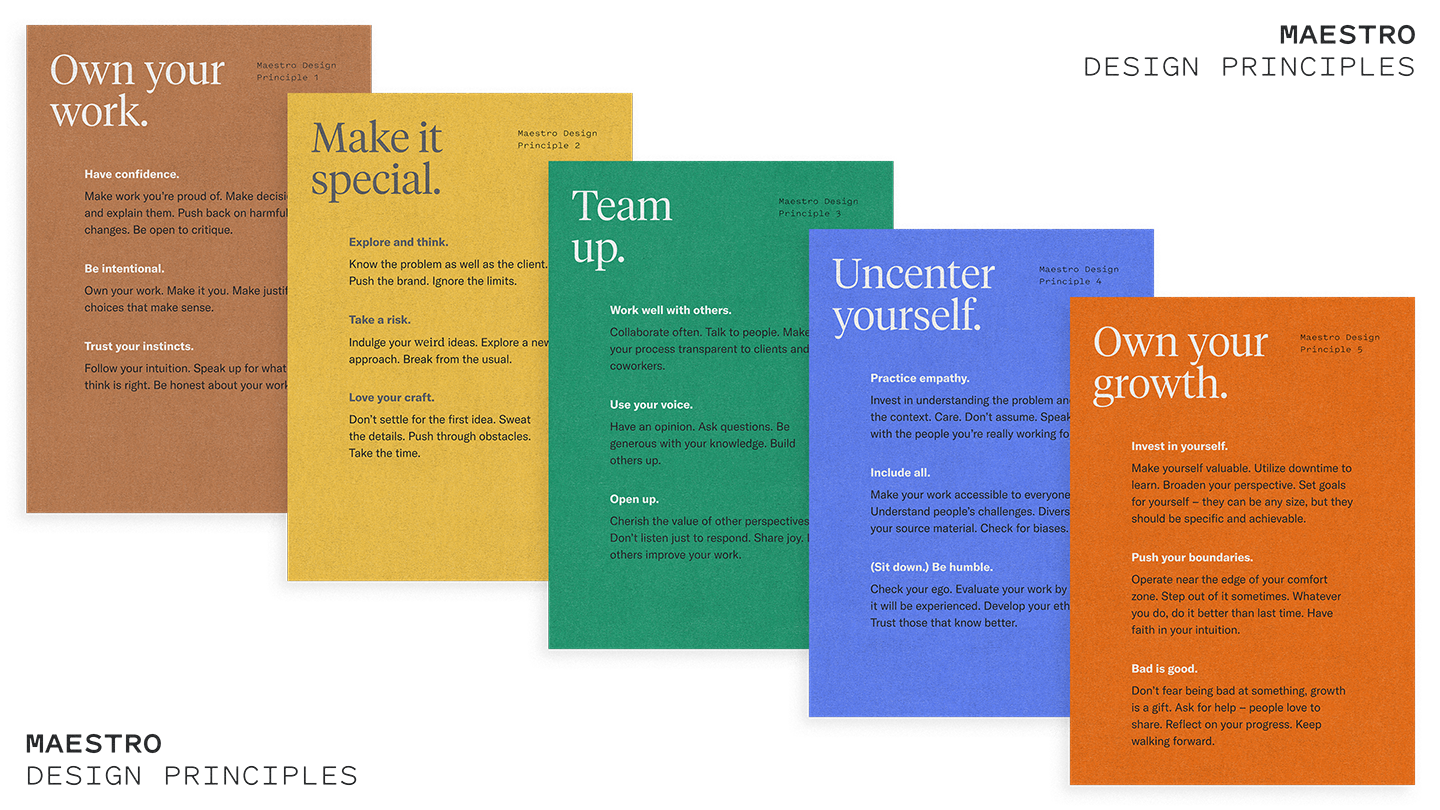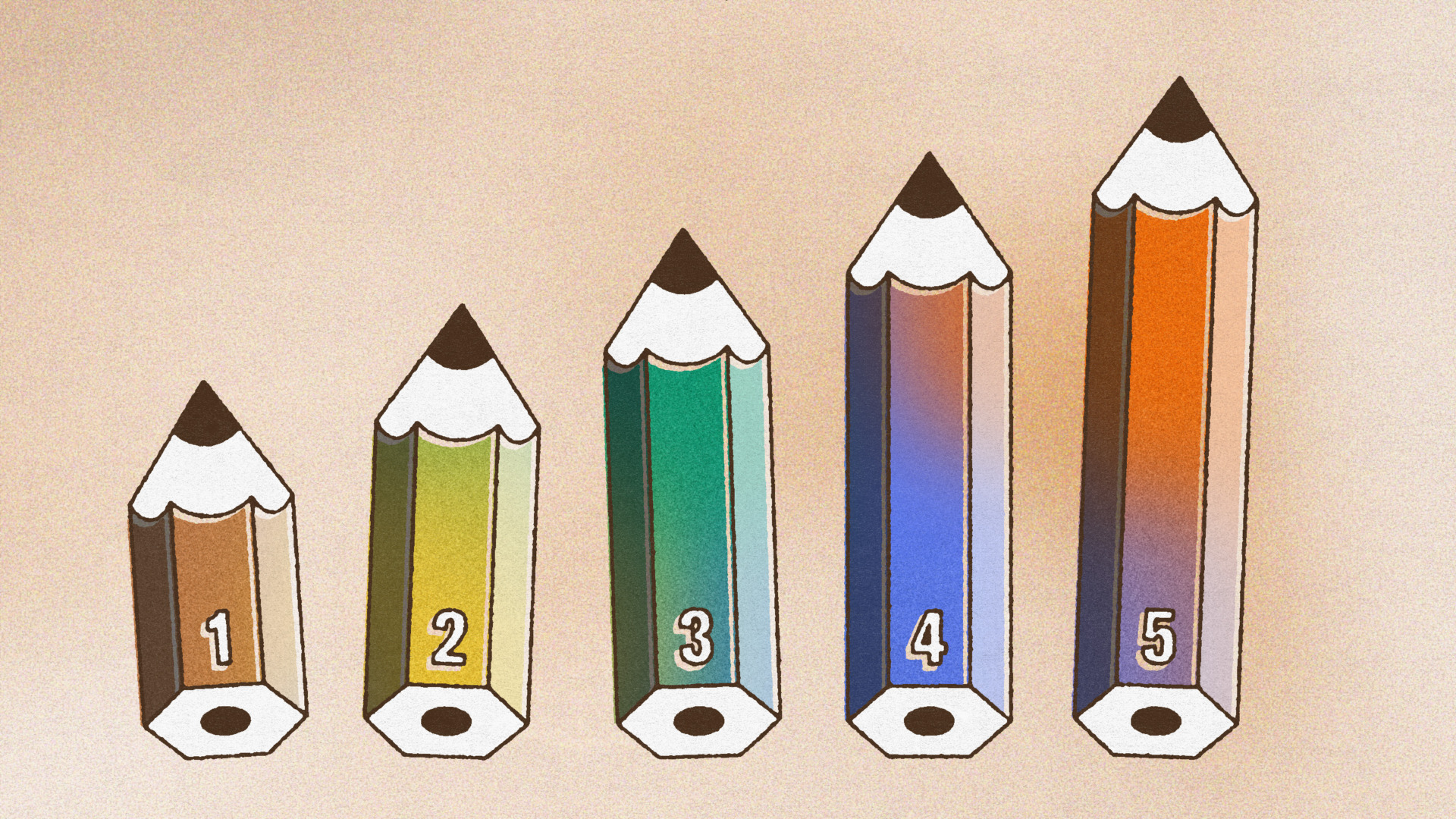At the heart of most purpose-driven organizations are their core values, mission, and vision. Your core values guide how your team members live and interact with one another, and your mission and vision define why the organization exists and the world you’re working to create. It all comes together through the processes that shape how you work together to solve problems.
At Maestro, we’ve thoughtfully crafted our values, mission, and vision, and we’ve built strong processes to support how we collaborate and move our work forward. But over the last two years, we discovered a missing piece to the puzzle of our organizational identity: team principles. When our teams are working from a set of shared principles specific to their craft, it sets a standard for consistently operating at a high level.
These key elements of our business—core values, mission and vision, principles, and process—build on and inform one another to empower us to truly achieve the change we’re trying to make in the world. Our Design team is leading the charge as the first to have collaboratively defined their set of shared principles, and we’re excited to share the process and final outcome.
If you’re looking to build consistency and craft on your teams, keep reading for a closer look at our Design team’s principles, how we got there, and how we operationalize them in our day-to-day work.
Maestro’s Design Principles
Our Design team’s principles are a set of unifying, guiding beliefs that help us do our best work. They’re not as strict as processes and not as high level as a vision or mission statement. They’re also focused on the team’s craft—in this case, design. Each principle is infused with and supports Maestro’s larger mission, vision, and values.
Although every principle can stand on its own, we expanded on each one with a bit of fine print that explains how we action and operationalize it. Let’s take a closer look.

1. Own your work.
Have confidence.
Make work you’re proud of. Make decisions and explain them. Push back on harmful changes. Be open to critique.
Be intentional.
Own your work. Make it you. Make justified choices that make sense.
Trust your instincts.
Follow your intuition. Speak up for what you think is right. Be honest about your work.
2. Make it special.
Explore and think.
Know the problem as well as the client. Push the brand. Ignore the limits.
Take a risk.
Indulge your weird ideas. Explore a new approach. Break from the usual.
Love your craft.
Don’t settle for the first idea. Sweat the details. Push through obstacles. Take the time.
3. Team up.
Work well with others.
Collaborate often. Talk to people. Make your process transparent to clients and coworkers.
Use your voice.
Have an opinion. Ask questions. Be generous with your knowledge. Build others up.
Open up.
Cherish the value of other perspectives. Don’t listen just to respond. Share joy. Let others improve your work.
4. Uncenter yourself.
Practice empathy.
Invest in understanding the problem and the context. Care. Don’t assume. Speak with the people you’re really working for.
Include all.
Make your work accessible to everyone. Understand people’s challenges. Diversify your source material. Check for biases.
(Sit down.) Be humble.
Check your ego. Evaluate your work by how it will be experienced. Develop your ethos. Trust those that know better.
5. Own your growth.
Invest in yourself.
Make yourself valuable. Utilize downtime to learn. Broaden your perspective. Set goals for yourself—they can be any size, but they should be specific and achievable.
Push your boundaries.
Operate near the edge of your comfort zone. Step out of it sometimes. Whatever you do, do it better than last time. Have faith in your intuition.
Bad is good.
Don’t fear being bad at something, growth is a gift. Ask for help—people love to share. Reflect on your progress. Keep walking forward.
How to create team principles
There’s no one way to create team principles, but it’s important that the process is intentional, collaborative, and inclusive.
To create our Design principles, we embarked on a series of workshops, alternating between divergent thinking (discovery) and convergent thinking (defining), to land on the five principles that best articulate our team’s shared beliefs. Here’s how we did it.
Initial brainstorming
Our first workshop was a creative and energizing endeavor. As we aim to do with all brainstorms, we built the session around divergent thinking: we held a free-flowing session designed to generate as many thoughts and ideas as possible. As a remote team, we used FigJam as our collaborative whiteboard environment, which allowed us to “embrace the mess” and ideate and brainstorm together.
For this initial session, our goal was to have team members dream into what their roles could be and take ownership of what the team could achieve. We used a warm-up activity (drawing animals in FigJam using the pencil tool—after all, we’re designers!) to get the team thinking creatively before moving into design-focused questions. Where do we want to be in five years? What do you want to see happen in the learning industry as a result of our influence? What could the impact be? The output of this workshop started to paint a picture of what an exciting work environment and culture looks like for our Design team.
Define and deliver
This is where the magic happens. For the second workshop, we shifted from divergent to convergent thinking to synthesize, organize and categorize our ideas. We also brought Maestro’s core values into the conversation to ensure our final principles were values-driven and aligned.
In one exercise, we worked together in FigJam to list out design skills and strategies and explore how they relate to each of our core values. For example, when we stand up for a design decision we think is right, that’s an expression of Maestro’s “Live boldly” core value.
From there, we moved into an affinity exercise, taking all of the sticky notes (not sure what we mean? Check out our guide on FigJam brainstorming) and grouping them by related themes. The team didn’t realize it at the time, but that was the magic moment when, as they were grouping ideas together, they were forming a shared perspective and set of beliefs about what design means at Maestro. By the end of the workshop, we had the foundation we needed to form values-infused, team-crafted principles.
The final step: wordsmith and polish. This is an exercise better suited to one or two individuals—one of our senior designers has a way with words, so we handed it off to him to craft principles that reflect the tone and aesthetic of our team. He presented them back to the group for feedback, and just like that, we had our finalized design principles.
Bring the principles to life
There’s little value in our principles if we’re not intentional about using them. To make them actionable, we wrote our principles in plain language and used phrases we actually say in our daily work lives. That way, it feels natural when they come up in one-on-ones and throughout projects. If you’re looking for more inspiration, we’re fans of how Figma crafted its design principles.
Speaking of Figma, our team works in the tool nearly every day—it made sense that our principles should live there. We created a component that attaches to any design file so that we’re visually reminded of our principles as we work. When it’s time for design critiques, we use our principles as a safe and unifying way to push each other to do our very best work. Does the design break from the usual? Does it serve the learner? Is it special?
A quick tip: once you create your principles, it’s great to periodically revisit them. We originally launched with just the first four principles, but when we revisited them months later, we realized there wasn’t anything about growth. We proposed the idea to the team and we all agreed to add a fifth principle: Own your growth.
We’re principled, and so is our work
Introducing team principles has helped us be more intentional and consistent in our day-to-day work. In the same way that our Learning Principles shape every experience we create, our team principles formalize the skill, craft, and dedication our people commit to their disciplines. With team principles guiding our daily activities, we can ensure we’re working at a consistently high standard at all times.
There’s real value in taking time to formalize what sets your organization—and your teams—apart. With clearly articulated values and principles, your team members have a unifying, guiding light for making good decisions and interacting with one another in a way that fulfills the company’s mission and vision. And when you involve them in the creation of it, you’ll find they’re more excited, engaged, and prepared to take ownership of the future you’re creating, together.
Dig deeper into our principled approach to learning
Our Learning Principles synthesize the brightest ideas in learning theory and design, combined with our experience and expertise, to create a clear lens for creating effective learning.
Get inspired→
